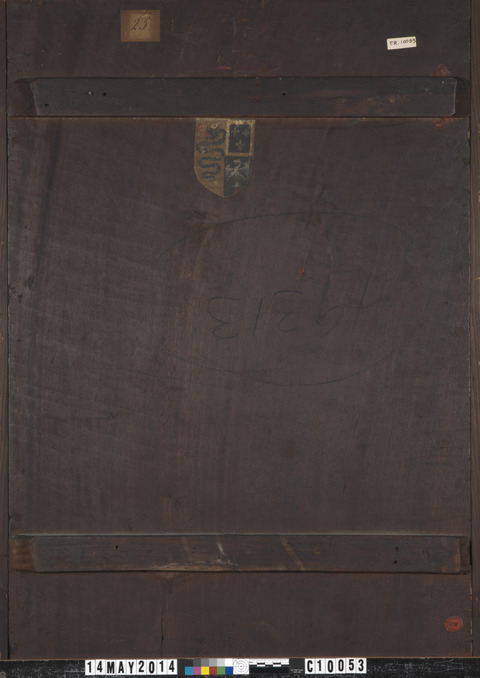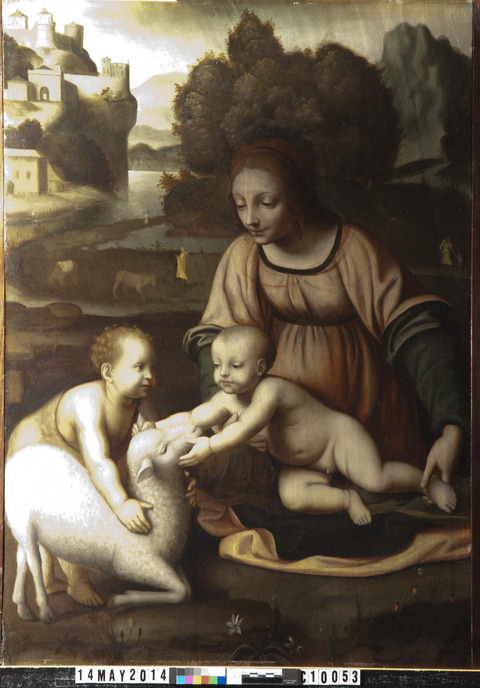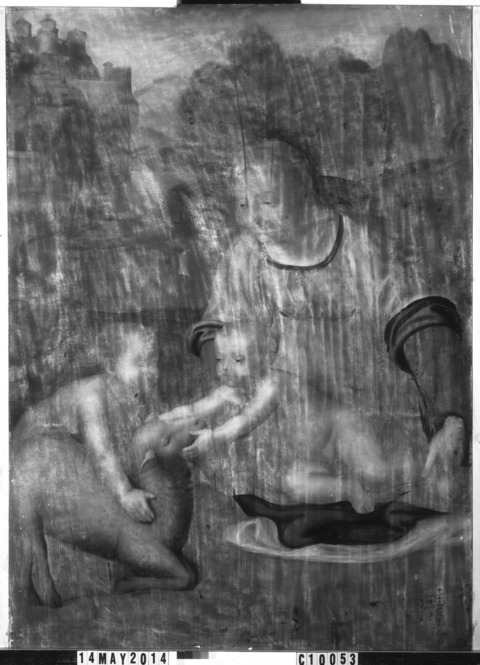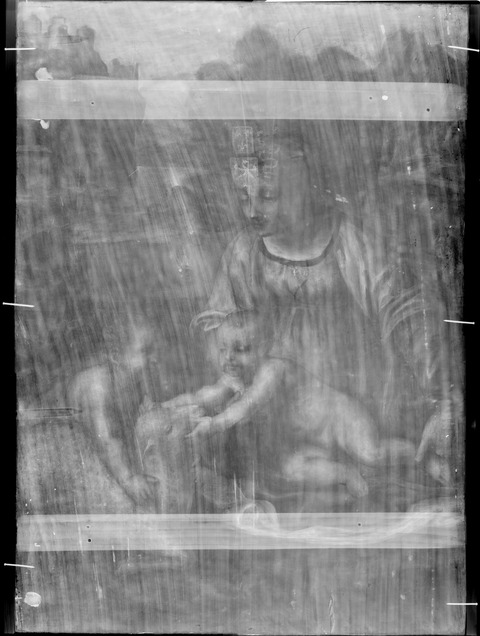Overview
Identification number: 2018.33
Artist: Workshop of Bernardino Luini
Title: Madonna and Child with St. John the Baptist and the Lamb
Materials: Oil on walnut panel
Date of creation: About 1525 or after
Previous number/accession number: C10053
Dimensions:
84.0 × 58.5 × 1.7–1.8 cm
84.0 × 61.5 × 1.7–1.8 cm with edge strips
Conservator/examiner: Fiona Beckett with contributions from Roxane Sperber
Examination completed: 2014, revised 2019
Distinguishing Marks
Front:
None
Back:
Item 1. Red circular wax seal, back, with embossed inscription, “BA” (tech. figs. 1, 2).
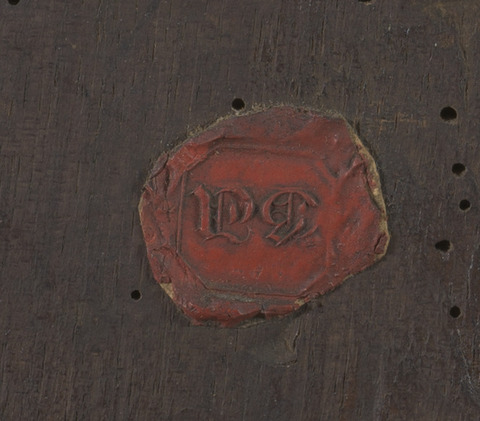
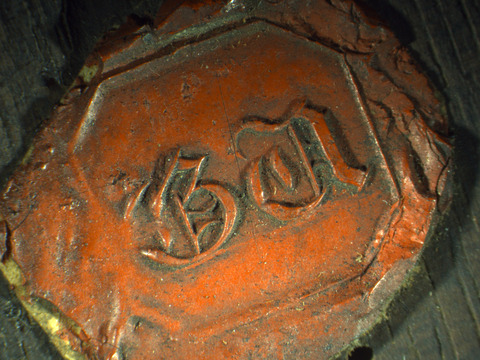
Item 2. Painted label, coat of arms with images of two dragons and three fleurs de lis (tech. fig. 3).
Item 3. Square label, top left, “23” (tech. fig. 3).
Item 4. White rectangular label, top right, “T.R. 10053” (tech. fig. 3).
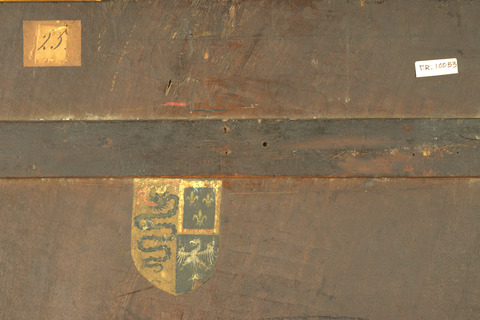
Item 5. Black crayon (upside down), “49313” (tech. fig. 4).
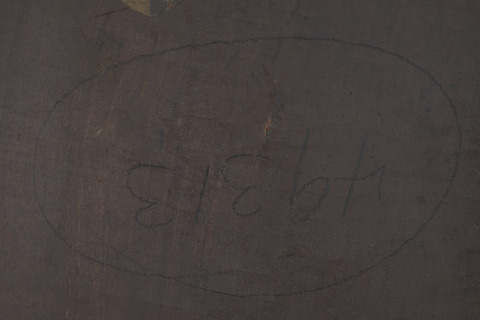
Summary of Treatment History
Physical evidence on the painting suggests it has been treated numerous times since its creation. While there is little evidence of structural intervention on the panel, the painting was undoubtedly cleaned and retouched, probably numerous times, prior to arriving at the IMA on long-term loan in 1971. A letter between George H.A. Clowes and restorer Roman C. Diorio suggested the painting was X-rayed and treated in 1941. Several letters from G.H.A. Clowes to Diorio implore him to move cautiously when cleaning the painting as Clowes feared it was in poor condition.1 In a letter from 19 October of that year, Diorio wrote:
The X-ray films of the Luini are not revealing any damage or distortion of importance exception [sic] for a little Pentiment on the sheep and few damage [sic] on the forehead of the Madonna. The painting is in good condition. I decided to clean it hoping to improve the painting from that dirth [sic] yellow varnish and altered restoration [sic]. I succeeded; although very thin, the painting has been preserved in rather good state.2
Documentation suggests a series of condition assessments and treatments were carried out on the collection about the time the works were moved from the Clowes residence to the IMA in 1971. A condition report by Paul Spheeris in October of that year, likely carried out before the paintings were relocated, described the painting as having a scratch on the right hand of St. John the Baptist and a chip on the frame. He described the painting as not being in immediate danger, but he commented that it had a “heavy natural resin varnish that is creating an undue amount of surface tension that could possibly cause cupping of the paint layer.” He recommended removal of the varnish to remedy this and enhance the appearance of the painting.3 A second condition assessment was carried out upon arrival of the paintings at the IMA. This assessment described the work as being in good condition except for the scratch. Treatment to inpaint the scratch was recommended.4
In 1974, a condition assessment, treatment, and investigation of the collection was carried out by the Intermuseum Conservation Association at Oberlin College. They described this painting as having a discolored and unevenly applied natural resin varnish that was exhibiting blooming. Treatment was recommended to remove the surface coating and restorer’s paint and to apply a new varnish and inpaint.5
Wood identification was performed by Peter Klein in February 1999.6 In May 2012, gelatin was applied to a small loss in the Madonna’s dress (under the neckline) to perform minor consolidation.
The condition of the painting was examined and documented in the Clowes Collection annual survey from 2011 to 2019.
Current Condition Summary
Aesthetically, the painting appears to be in relatively good condition. There are a few visible areas of discolored retouching in the Christ child’s head and upper area of the background. There are also noticeable areas of abrasion in the Madonna’s veil and robe as well as in the trees in the background. The strangely cool color of the painting suggests significant fading may have occurred. Structurally, the painting is sound. There is a 3 cm split at the bottom of the panel, which appears to have been present for a long time and is currently stable.
Methods of Examination, Imaging, and Analysis
| Examination/Imaging | Analysis (no sample required) | Analysis (sample required) |
|---|---|---|
| Unaided eye | Dendrochronology | Microchemical analysis |
| Optical microscopy | Wood identification | Fiber ID |
| Incident light | Microchemical analysis | Cross-section sampling |
| Raking light | Thread count analysis | Dispersed pigment sample |
| Reflected/specular light | X-ray fluorescence spectroscopy (XRF) | Fourier-transform infrared spectroscopy (FTIR) |
| Transmitted light | Macro X-ray fluorescence scanning (MA-XRF) | Raman microspectroscopy |
| Ultraviolet-induced visible fluorescence (UV) | ||
| Infrared reflectography (IRR) | Gas chromatography–mass spectrometry (GC-MS) | |
| Infrared transmittography (IRT) | Scanning electron microscope -energy dispersive X-ray spectroscopy (SEM-EDS) | |
| Infrared luminescence | Other: | |
| X-radiography |
Technical Examination
Description of Support
Analyzed Observed
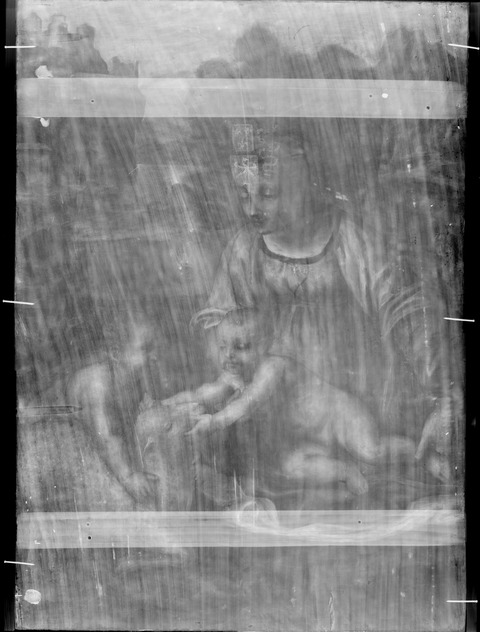
Material (fabric, wood, metal, dendrochronology results, fiber ID information, etc.):
The support is a wood panel with vertically orientated grain (tech. fig. 5). The grain is not perfectly straight, rather it exhibits slight curvature to the left. The wood was identified by dendrochronologist Peter Klein as walnut (Juglan ssp.).7 While not common, walnut supports have been found on other examples of Italian paintings.8
Characteristics of Construction / Fabrication (cusping, beveled edges of panels, seams, joins, battens):
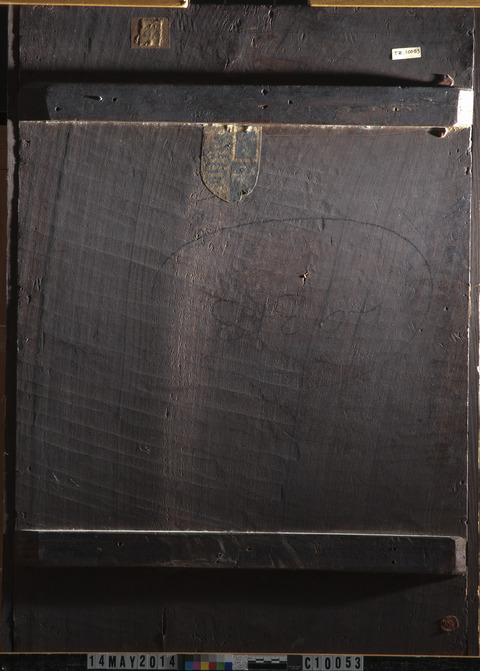
The panel is constructed from a single wooden panel and is on average 1.8 cm thick with slight variations in thickness. Horizontal tool marks are visible on the back of the panel (tech. fig. 6), indicating that the panel was hand tooled. Large striations in the wood grain are also visible on the front through the paint, especially when the panel is viewed with raking light (tech. fig. 7).
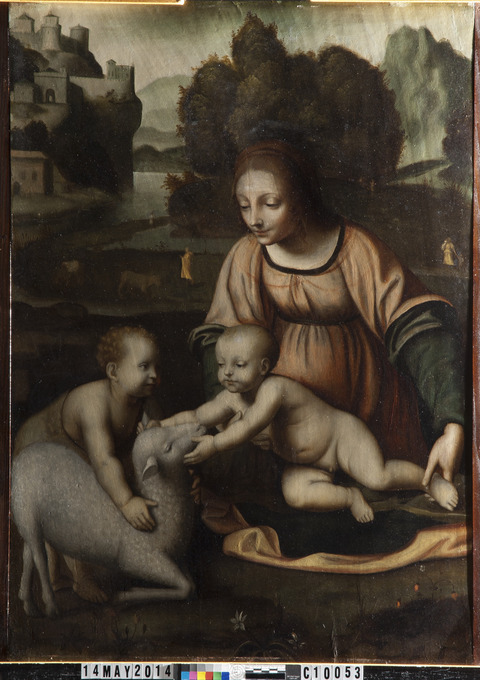
The back of the panel has two battens (see Auxiliary Support).
Interestingly, the X-radiograph reveals that the left side of the support has two wooden dowels (tech. fig. 5). The dowels have been cut at the edge of the panel and would have originally extended beyond the panel’s edge (tech. figs. 8, 9). This may suggest that the painting was attached to another panel or frame. There are no dowel channels on the right edge of the painting.
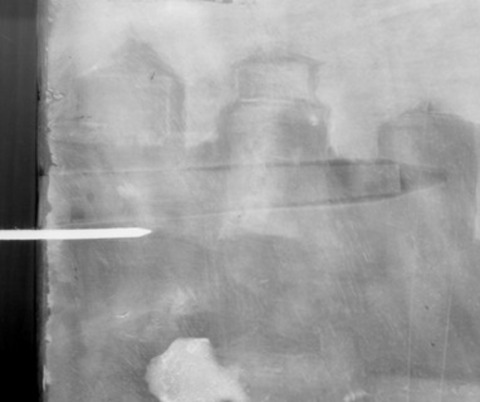
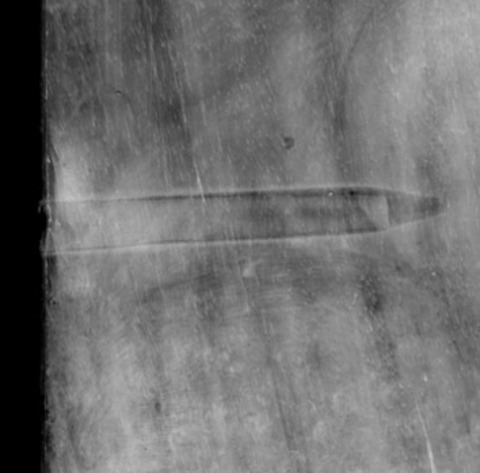
Thickness (for panels or boards):
The panel is approximately 1.8 cm thick with slight variation across the wood.
Production/Dealer’s Marks:
Two interesting production marks are present on the back of the panel. First, a coat of arms label is glued just below the upper batten (tech. fig. 3). The label portrays a dragon, three fleurs de lis, and a bird (possibly an eagle). This appears to have been fixed to the panel with animal glue. The label itself is painted with red, white, and blue pigments. In the X-radiograph, the paint on the label appears radio-opaque.
Second, a red seal with the letters “BA” is stamped on the bottom right of the back of the panel (tech. figs. 1, 2). The red, waxy material appears to be pigmented, perhaps red lead or vermilion, as it also is radio-opaque in the X-radiograph. Additionally, residues of what may have been another red seal are present on the upper batten but seem to have been removed or worn off over time (tech. fig. 10).

Auxiliary Support:
Original Not original Not able to discern None
Attachment to Auxiliary Support:
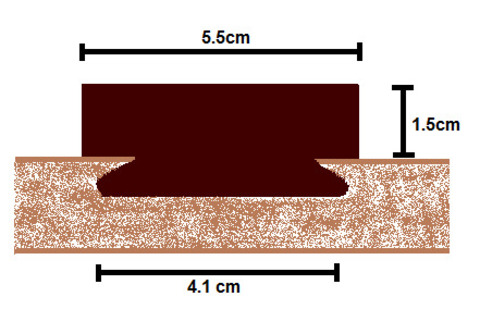
The back of the panel has two battens which are the same width as the panel (58.5 cm long) and are beveled at the edges. The uppermost batten is 5.5 cm wide, while the lower batten is 4.7 cm. Both are about 1.5 cm thick. The battens appear to have been secured in place with dovetail grooves in the panel (tech. fig. 11) and appear to be constructed from the same wood as the panel. The battens were likely added to the panel at the time the panel was created, as this type of crossbeam was widely used on Italian supports beginning in the early sixteenth century. 9 The panel itself does not appear to be thinned.
Edge strips are attached to both the right and left edge of the panel in order to fit the painting to the frame.
Condition of Support
The panel is currently in excellent condition and remains remarkably planar despite the uneven grain pattern and possibly uneven cut of the wood. One split is present in the bottom of the panel located 17.2 cm from the lower-right edge of the painting, measuring 3 cm in length. The split leads to a few hairline cracks in the paint but is stable and seems to have been present for a long time. There is slight wear along the top and bottom edges.
Description of Ground
Analyzed Observed
Materials/Binding Medium:
The ground layer is off-white in color and may be calcium sulfate (gesso) given the Italian origins of the painting. XRF analysis detected calcium in numerous locations across the painting (see Table 1).
Color:
The ground, where seen along the edges and in one split, is off-white in color (tech. fig. 12). It appears to have yellowed slightly over time. In most areas, the ground is not visible. Given the greenish tones in the whites, it is possible that a second layer of colored ground exists, although it is difficult to determine with any certainty without sampling.
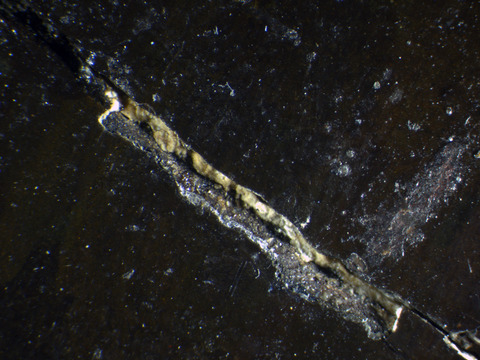
Application:
The ground was likely brushed on after the panel was coated with size.
Thickness:
The ground appears to be a single layer of medium thickness.
Sizing:
While not visible, animal-glue size would likely have been applied to the panel prior to the ground layer, possibly on both sides.
Character and Appearance (Does texture of support remain detectable / prominent?):
The wood grain is visible through the paint and ground layers in the form of large striations. The grain seems to be curved, perhaps from a warped section of a tree.
Condition of Ground
Where visible, the ground appears to be in stable condition and well-adhered to both the support and the paint layers. No delamination is visible.
Description of Composition Planning
Methods of Analysis:
Surface observation (unaided or with magnification)
Infrared reflectography (IRR)
X-radiography
Analysis Parameters:
| X-radiography equipment | GE Inspection Technologies Type: ERESCO 200MFR 3.1, Tube S/N: MIR 201E 58-2812, EN 12543: 1.0mm, Filter: 0.8mm Be + 2mm Al |
|---|---|
| KV: | 26 |
| mA: | 3 |
| Exposure time (s) | 90 |
| Distance from X-ray tube: | 36" |
| IRR equipment and wavelength | Opus Instruments Osiris A1 infrared camera with InGaAs array detector operating at a wavelength of 0.9-1.7µm. |
Medium/Technique:
The medium of underdrawing appears to be a liquid.
Pentimenti:
No pentimenti are visible; however, some underdrawing is visible around the figures when the painting is imaged using infrared reflectography (see tech. fig. 14 below). The underdrawing appears as outlining and reinforcement of the design. The quality and fluidity of the outlines are indicative of a liquid medium, such as a pigmented watercolor or ink. No evidence of pouncing or other forms of cartoon transfer are observable, although some may be present in a material that is not infrared absorbent, such as red chalk. There appears to be clear precision in the formation of most figures, suggesting that there may have been a guiding composition. There are a few minor adjustments in the composition where the artist worked out the dimensions. The adjustments occur in the outlines of the Madonna’s head in large tentative brushwork, as well as in the fabric by the Christ child’s proper left foot. Several areas, including the Madonna’s sleeve and the fabric under the Christ child, appear dark in the infrared reflectogram (tech. fig. 13). This is likely due to the use of copper-containing pigments such as azurite or malachite, which absorb infrared radiation in the wavelengths measured by the Osiris infrared camera. The robe near the Christ child’s foot is clearly painted around the foot, indicating that the foot was already in the composition when the robe was painted. Additional observations of the infrared reflectogram include large striating lines of the panel (likely the ground and paint preferentially accumulating in the lower valleys of the panel’s texture), and relatively large brushwork used to paint in the background.
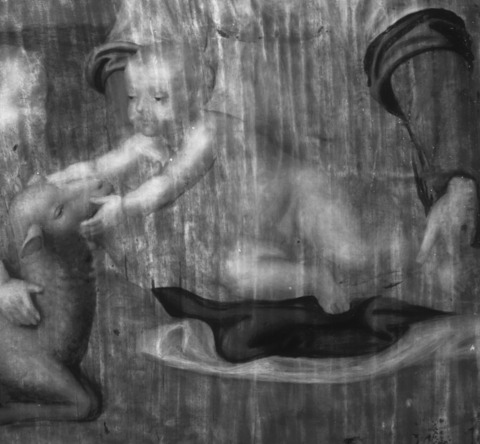
An almost identical painting exists at the Museo Nacional Thyssen-Bornemisza, Madrid (see tech. fig. 17 below). In infrared reflectography, the Museo Thyssen-Bornemisza version (provided by Eugenia Alonso Asensio, assistant Old Masters curator, 27 June 2014) shows underdrawing in the form of outlining, reinforcement, and refining of the composition (tech. fig. 15). The underdrawing appears to have been done with a fluid medium, possibly in conjunction with a dry medium such as chalk (some underdrawing may not be visible in the infrared reflectogram). Some adjustments were made to the Thyssen composition, including the proper left foot of the Christ figure, which was moved to the right thereby showing more of the Madonna’s fingertips. An adjustment was also made to the lamb’s knee to make it smaller. Some blue areas appear very light in the IRR image of the Museo Thyssen-Bornemisza painting while others appear dark, indicating the use of several kinds of blue pigments. The IRR images of both paintings appear quite different in their style of under-drawing, with the Indianapolis version being less delicately rendered and painted with larger brushes.
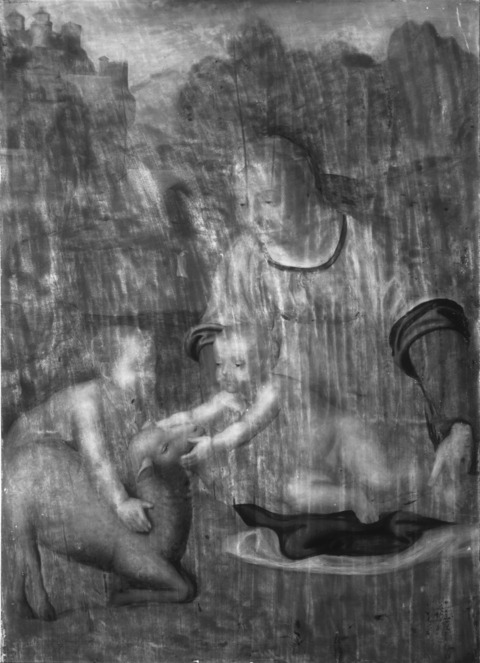
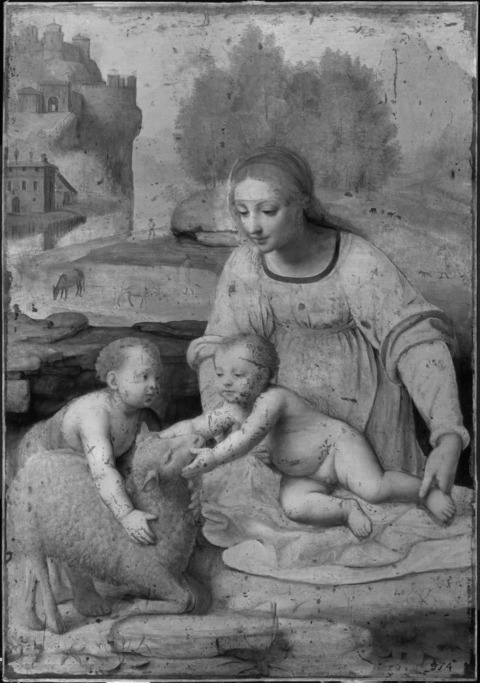
Description of Paint
Analyzed Observed
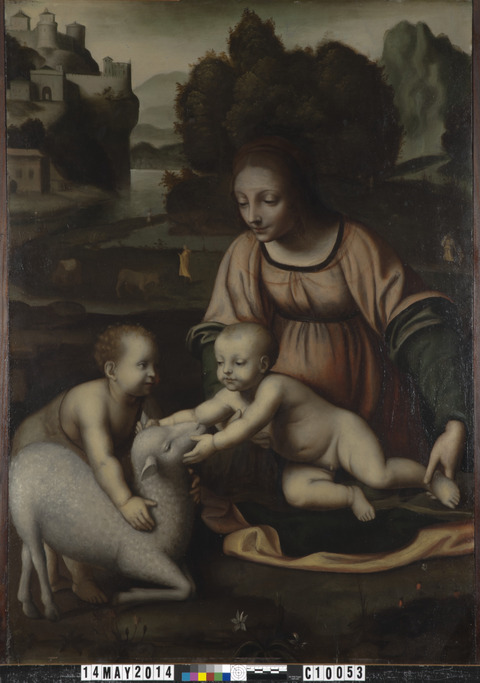
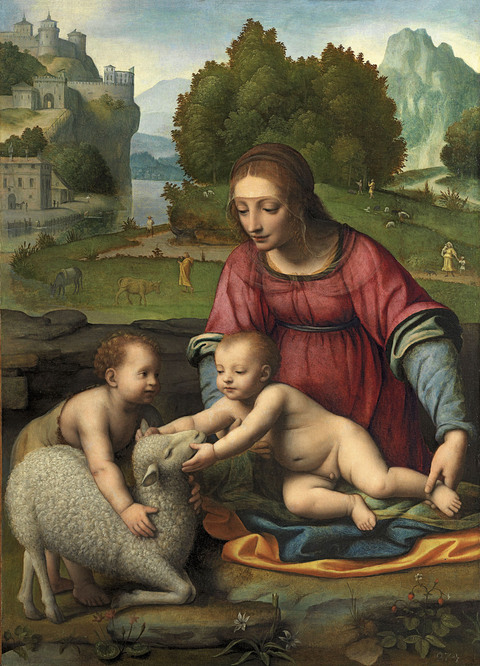
Application and Technique:
The paint was thinly applied with a variety of small and larger brushes. The figures' faces and small details were delicately painted, while the drapery and backgrounds were painted somewhat quickly with larger, more sweeping brushstrokes. A chiaroscuro effect is also used in the painting, creating a dramatic light on the figures. Thin glazes were applied in several areas, including the Madonna’s robe and veil, hair of the figures, and trees. Glazes were likely applied in several other places but have since been abraded during previous cleaning campaigns.
Despite being on different supports, the Clowes painting is almost identical to the Museo Thyssen-Bornemisza version (tech. fig. 16). They are nearly identical in dimensions, and the compositions are similar except for the windows in the buildings, the brushwork of the rocks and fabrics, the lamb’s wooly coat, the Madonna’s proper left sleeve, and tonal values in greens and blues. The colors are also more vibrant in the Museo Thyssen-Bornemisza version, and the composition is more detailed and finely painted (tech. fig. 17). The Clowes painting may have been a copy, possibly within a workshop context, after the Museo Thyssen-Bornemisza version that is attributed to Luini’s hand.
Painting Tools:
The painter employed brushes of varying sizes. There is no evidence of palette knife or other hard-edged tools.
Binding Media:
The binding media is likely oil, but this has not been confirmed through analysis.
Color Palette:
Earthy and greenish hues comprise much of the painting, particularly the landscape. The artist also used reds, beige, pinks, ochers, and white. The color palette is cool and rather washed-out when compared to the vibrancy of the Museo Thyssen version. This may be a result of fading or perhaps the use of lower-quality pigments. Additionally, such coloring could be indicative of the painting being copied after another painting that had already exhibited a discolored varnish (possibly the Thyssen painting). More information could be gleaned if the painting were to be treated.
XRF analysis suggests the presence of lead white, lead-tin yellow, copper-containing green and/or blue pigments, iron oxide (earth pigments), and a small amount of vermilion on the artist’s palette (tech. fig. 18). Mercury was detected in the lips and cheek of the Madonna, suggesting the presence of vermilion in these areas. No mercury was detected in the robe of the Madonna, and the faded appearance suggests the possible use of red lake pigments in this area. It is also possible that now faded red lake pigments were used to paint the skin of the children and the Madonna, which may explain their pallid appearance. Mercury was also absent from an orange-red flower in the foreground. It is possible that red lead was in fact used in that area, although the presence of red lead was not confirmed. In the blue and green areas, strong peaks for copper were detected, suggesting the use of azurite in the blue areas and either azurite mixed with yellow ocher in the greens or, perhaps more likely, a copper resinate or copper oleate. The IR-absorbent blue sleeve and blanket in the Clowes version, when compared to the Museo Thyssen version, suggests the use of different pigments. The IR transparency of these areas in the Museo Thyssen version may suggest the use of expensive ultramarine blue rather than a copper-containing pigment such as azurite. Copper was also detected in the sky and mountain range. The gray appearance of these pigments may point to the use of a low-quality azurite pigment
XRF Analysis:
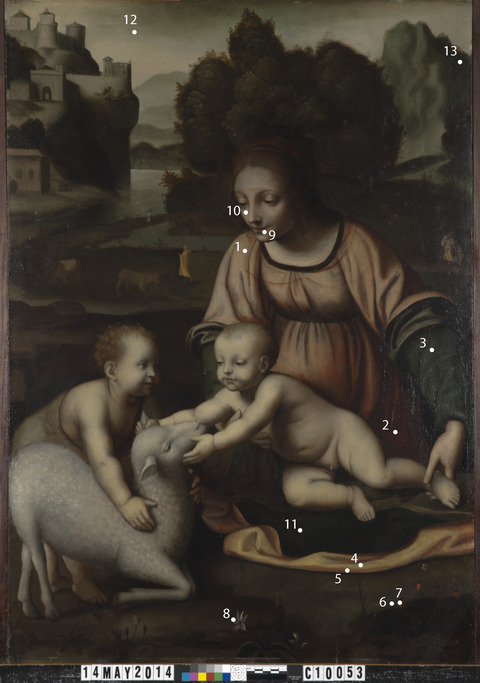
| Sample | Location | Elements | Possible Pigments |
|---|---|---|---|
| 1 | Madonna’s red dress, highlight | Major: Pb Minor: Trace: Fe, Cu | Lead white, trace of iron oxide (earth pigments), possible red lake (not detectable using XRF), trace of copper-containing green and/or blue pigment. |
| 2 | Madonna’s red dress, shadow | Major: Pb Minor: Fe, Cu Trace: Ca | Lead white, iron oxide (earth pigments), copper-containing green and/or blue pigment, trace of calcium (from the ground layer), possible red lake (not detectable using XRF). |
| 3 | Madonna’s blue-green sleeve | Major: Cu, Pb Minor: Fe Trace: Ca | Copper-containing green and/or blue pigment, lead white, iron oxide (earth pigments), calcium (from the ground layer). |
| 4 | Yellow blanket, highlight | Major: Pb Minor: Trace: Fe, Sn, Cu, Ca | Lead-tin yellow and/or lead white, trace of iron oxide (earth pigments), trace of copper-containing green and/or blue pigment, trace of calcium (from the ground layer). |
| 5 | Yellow blanket, shadow | Major: Pb Minor: Fe Trace: Sn, Cu, Ca | Lead-tin yellow and/or lead white, iron oxide (earth pigments), trace of copper-containing green and/or blue pigment, trace of calcium (from the ground layer). |
| 6 | Green foreground | Major: Cu, Pb Minor: Fe Trace: Ca | Copper-containing green and/or blue pigment, lead white, iron oxide (earth pigments), trace of calcium (from the ground layer). |
| 7 | Red flower in foreground | Major: Pb Minor: Cu Trace: Fe | Lead white, copper-containing green and/or blue pigment, trace of iron oxide (earth pigments), possible red lead (not confirmed using XRF). |
| 8 | Blue flower | Major: Pb Minor: Cu Trace: Fe | Lead white, copper-containing green and/or blue pigment, trace of iron oxide (earth pigments). |
| 9 | Madonna’s lips | Major: Pb Minor: Hg, Trace: Cu, Fe, Ca | Lead white, vermilion, copper-containing green and/or blue pigment, trace of iron oxide (earth pigments), trace of calcium (from the ground layer). |
| 10 | Madonna’s cheek | Major: Pb Minor: Trace: Fe, Cu, Hg, Ca | Lead white, trace of vermilion, trace of copper-containing green and/or blue pigment, trace of iron oxide (earth pigments), trace of calcium (from the ground layer). |
| 11 | Blue blanket | Major: Cu, Pb Minor: Fe, Ca Trace: Hg | Copper-containing blue and/or green pigment, lead white, iron oxide (earth pigments), calcium (from the ground layer), trace of vermilion. |
| 12 | Sky | Major: Cu, Pb Minor: Fe Trace: Co, Ni, Ca | Copper-containing blue and/or green pigment, lead white, iron oxide (earth pigments), calcium (from the ground layer), trace of smalt or cobalt blue retouching. |
| 13 | Mountain | Major: Cu, Pb Minor: Fe, Ca Trace: | Copper-containing green and/or blue pigment, lead white, iron oxide (earth pigments), calcium (from the ground layer). |
Table 1: Results of X-ray fluorescence analysis conducted with a Bruker Artax microfocus XRF with rhodium tube, silicon-drift detector, and polycapillary focusing lens (~100μm spot).
*Major, minor, trace quantities are based on XRF signal strength not quantitative analysis
Surface Appearance:
The paint appears to be applied in a relatively thin manner with no areas of impasto.
Condition of Paint
A micro-cracking pattern from natural aging extends over the entire painting. Small paint losses are scattered throughout. Some wear is visible around the perimeter of the painting where the paint is in contact with the frame. Some of the paint has been heavily abraded from a previous cleaning. This is particularly noticeable in the glazes of the figures' hair, the brown trees in the background, the Madonna’s veil (tech. fig. 19) and drapery, and in the wooly coat of the lamb. Most of the abrasion occurs in the brown tones and glazes. Additionally, it is likely that the Madonna’s robe was a darker red-orange color similar to the Luini painting at the Museo Thyssen but was damaged during a past varnish removal or cleaning. It likely also contained lake pigments that have faded over time.
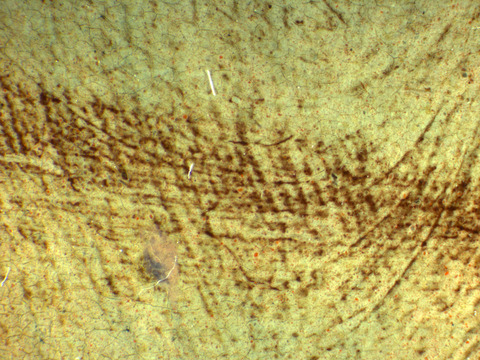
Description of Varnish/Surface Coating
Analyzed Observed Documented
| Type of Varnish | Application |
|---|---|
| Natural resin | Spray applied |
| Synthetic resin/other | Brush applied |
| Multiple Layers observed | Undetermined |
| No coating detected |
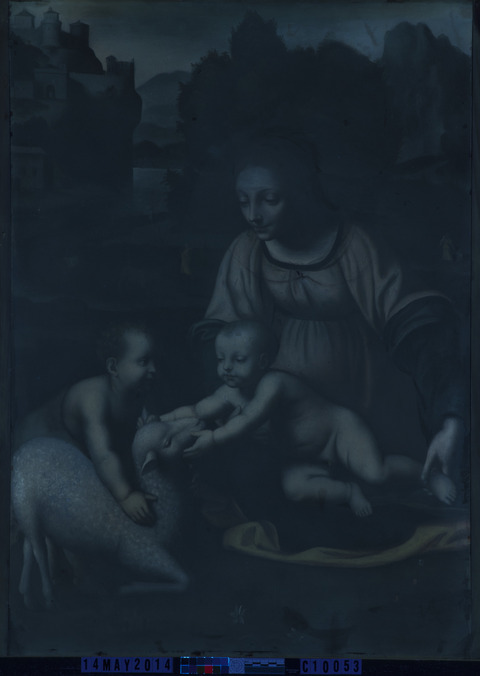
Observation of the painting under ultraviolet-induced visible fluorescence reveals the presence of an aged natural resin varnish over the surface of the painting (tech. fig. 20), which corresponds to the painting’s slightly yellowed appearance. There are several campaigns of retouching present from an older restoration, as well as that of a more recent inpainting campaign.
Condition of Varnish/Surface Coating
The varnish is discolored. Despite this, the paint layers are cool in appearance, and while they would certainly look lighter with varnish removal, the overall tone would still be cool. A few small scuffs and minor losses are visible, particularly around the perimeter where the painting is in contact with the frame. Otherwise, the varnish is intact. Surface dirt is present in small amounts throughout the painting.
There is some retouching that has discolored and no longer matches the surrounding paint layers (tech. fig. 21). The most recent retouching fluoresces under ultraviolet light. Older retouchings are present, for example in the face, but this campaign does not fluoresce.
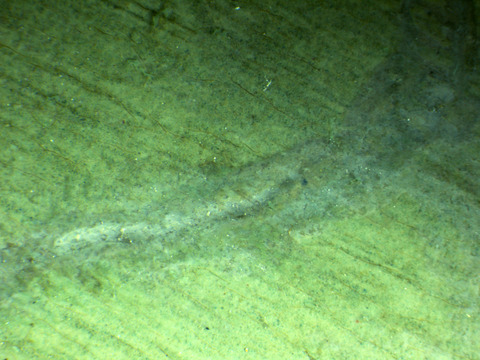
Description of Frame
Original/first frame
Period frame
Authenticity cannot be determined at this time/ further art historical research necessary
Reproduction frame (fabricated in the style of)
Replica frame (copy of an existing period frame)
Modern frame
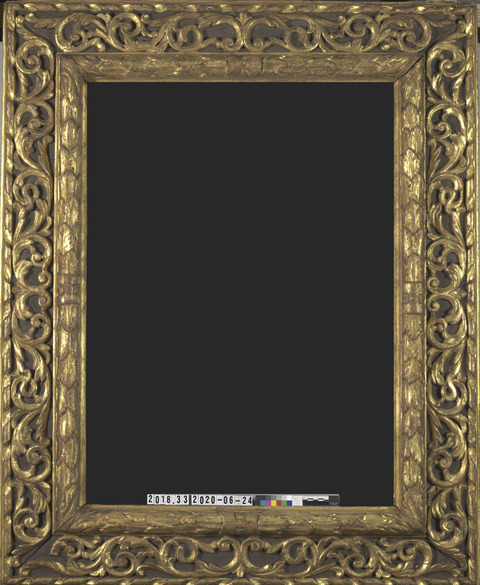
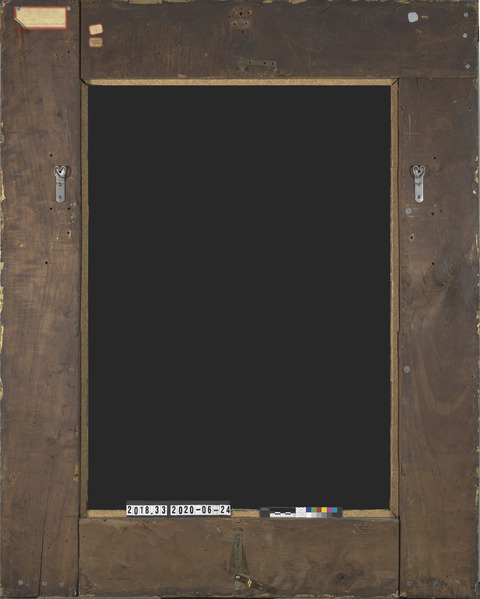
Frame Dimensions:
Outside frame dimensions: 115.5 × 93.0 × 7.0cm
Sight size: 82.0 × 59.0 cm
Distinguishing Marks:
Item 6. Clowes fund label, white with double red border, top left, typed and stamped (tech. fig. 24):
“THE CLOWES FUND…
FINE ARTS DEPARTMENT
3744 SPRING HOLLOW ROAD
INDIANAPOLIS 8, INDIANA U.S.A
No. 32. Luini
Madonna, child, St. John and the lamb”
Item 7. Small white label with double red border with pencil, “6734/38” (tech. fig. 24).
Item 8: Small white label with double red border with pencil, “4998/1,” that has been scribbled out (tech. fig. 24).
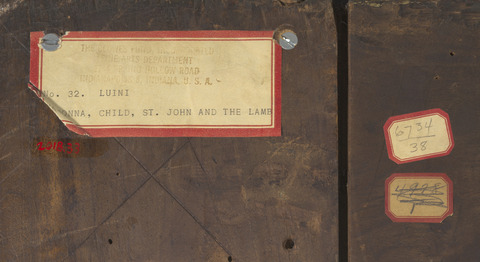
Item 9. Carved incision in wood of frame, center top. Appears to be “otp” with a circle around it (tech. fig. 25).
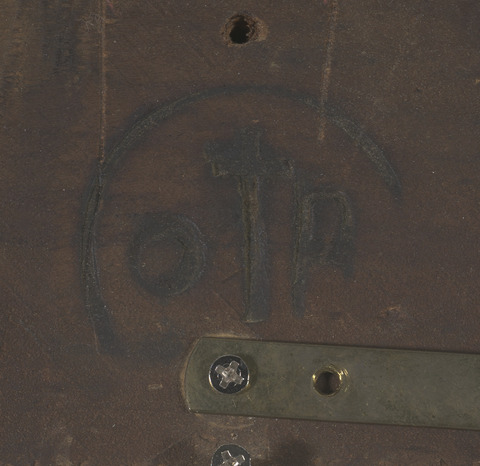
Description of Molding/Profile:
The frame dates to the early seventeenth century (about 1620).10 It is constructed from carved poplar with the top edge having laurel leaves radiating out from clamped centers (tech. fig. 22). The frame was originally larger and reduced in size by replacing the back frame (tech. fig. 23). The condition and treatment of the construction suggest this intervention was done in about 1930.11 The branded mark on the back (tech. fig. 25) could be of the framer who adjusted the frame or the collection to which the frame belonged.12
The frame is gilt and has a dark red layer of bole beneath the gold leaf. The frieze has pierced cauliculi with a gray background. The back edge of the frame has a decorative twisted ribbon. According to Timothy Newbery, the frame was probably originally blue and gold, derived from the Bolognese patterns by architect and sculptor Andrea Marchesi da Formigine.13
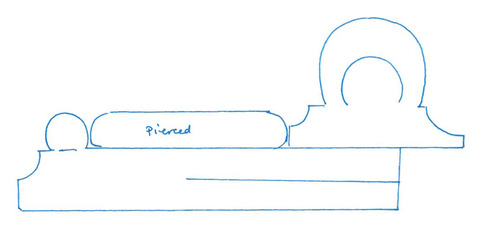
Condition of Frame
The frame is in relatively good condition. It was damaged in the past and later restored with the gesso and gilding reworked. The gesso is flaking slightly and requires consolidation.
Notes
-
Letters from G.H.A. Clowes to Roman C. Diorio, 3, 19, 18 September 1941, Correspondence Files, Clowes Registration Archive, Indianapolis Museum of Art at Newfields. ↩︎
-
Letter from Roman C. Diorio to G.H.A. Clowes, 19 October 1941, Correspondence Files, Clowes Registration Archive, Indianapolis Museum of Art at Newfields. ↩︎
-
Paul A.J. Spheeris, “Conservation Report on the Condition of the Clowes Collection,” 25 October 1971, Conservation Department Files, Indianapolis Museum of Art at Newfields. ↩︎
-
Martin Radecki, Clowes Collection condition assessment, undated (after October 1971), Conservation Department Files, Indianapolis Museum of Art at Newfields. ↩︎
-
Intermuseum Conservation Association, “Clowes Collection Conservation Report,” C10053 (2018.33), 8–10 April 1974, Conservation Department Files, Indianapolis Museum of Art at Newfields. ↩︎
-
Peter Klein, wood identification report, C10005 (2020.1), 1999, Conservation Department Files, Indianapolis Museum of Art at Newfields. ↩︎
-
Peter Klein, wood identification report, C10053 (2018.33), 1999, Conservation Department Files, Indianapolis Museum of Art at Newfields. ↩︎
-
Luca Uzielli, “Historical Overview of Panel-Making Techniques in Central Italy,” in The Structural Conservation of Panel Paintings: Proceedings of a Symposium at the J. Paul Getty Museum, 24–28 April 1995, ed. Kathleen Dardes and Andrea Rothe (Los Angeles, CA: Getty Conservation Institute, 1998), 114. ↩︎
-
Luca Uzielli, “Historical Overview of Panel-Making Techniques in Central Italy,” in The Structural Conservation of Panel Paintings: Proceedings of a Symposium at the J. Paul Getty Museum, 24–28 April 1995, ed. Kathleen Dardes and Andrea Rothe (Los Angeles, CA: Getty Conservation Institute, 1998), 125. ↩︎
-
Timothy Newbery, condition report on frame for C10015, 16 January 2012, Conservation Department Files, Indianapolis Museum of Art at Newfields. ↩︎
-
Email communication with Timothy Newbery, 1 July 2020. ↩︎
-
Marks from this date are suspicious because they were often applied to make a frame seem more important. Framers did not usually brand their frames in the seventeenth and eighteenth centuries. Rather, a framer would have written their name in ink or used a name punch. A collection would have applied a wax seal. Email communication with Timothy Newbery, 1 July 2020. ↩︎
-
Timothy Newbery, condition report on frame for C10015, 16 January 2012, Conservation Department Files, Indianapolis Museum of Art at Newfields. ↩︎
Additional Images

